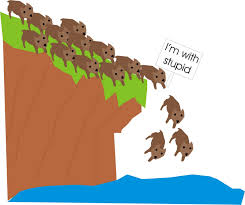Kool-Aid, Groupthink and Generative Governance
By Dani Robbins
Re-published with permission from nonprofit evolution blog
 There have been multiple things that have happened in the past week that have made me re-consider the phrase “Don’t drink the Kool-Aid.”
There have been multiple things that have happened in the past week that have made me re-consider the phrase “Don’t drink the Kool-Aid.”
The first was a Board that was exploring introducing a new funding model. The Board, who had been on the inside of a discussion of culture shift for the past year and were familiar with the materials and the arguments, briefly considered not building the organizational culture to introduce the considered change because they “didn’t think it was a big deal.” And it wasn’t a big deal to them because they’d already changed the culture among their group. They’d been thinking about it and reading about it and interviewing other groups that had already implemented the change and there was consensus among the group that it was the right direction for their organization.
Yet… even when there is agreement on the board, there is still the need to create buy-in among others. Without buy-in the potential for failure is high unless all constituents understand the need for change and the foundation is created to implement that change.
The second thing is, in fact, an illustration of just that. The second thing was a local commission’s decision to put forth a levy in the midst of a scandal. They weren’t wrong. They had done their homework, and looked at the issues and put forth a solid plan to introduce change. It failed, primarily and among other things because even though they had a plan to introduce the change and the leaders of the city were behind them, they didn’t have the informal community leaders on board and those leaders didn’t sell it to their constituents.
My intent is not to criticize any of these leaders. Each was in a difficult position and after considering all the options, made the decision that they felt best served their organization, their community and their constituents. That is the very definition of good leadership. Another component of good leadership is to learn from our mistakes and missteps. To that point, we need to ask:
What could have helped? What might have made the difference?
I believe the answer is generative governance. Let’s review how some of the techniques offered in my favorite board book “Governance as Leadership” could have made the difference.
 “Silent Starts — Set aside 2 minutes for each trustee to anonymously write on an index card the most important question relevant to the issue at hand.”
“Silent Starts — Set aside 2 minutes for each trustee to anonymously write on an index card the most important question relevant to the issue at hand.”
What if a board or commission member had written: “How can we engage community and committee leaders as well as those in informal leadership positions who could, in turn, engage their constituents?”
“One Minute Memos — At the end of discussions give each member 2-3 minutes to write down any thoughts or questions that were not expressed.”
This could have been a great opportunity to consider the worst case scenarios and create a plan ensure against such eventualities.
“Counter Points — Randomly designate 2-3 trustees to make the powerful counter arguments to initial recommendations.”
This could have been used to dispel all the arguments against the change. From that discussion, marketing materials, talking points and an engagement plan could have been created.
“Role Play — Ask a subset of the Board to assume the perspective of different constituent groups likely to be affected by the decision at hand.”
A board member could have taken on the role of a member of the community who would be the most negatively impacted by the change and a plan could be created to embrace those constituents and mitigate their impact.
“Breakouts — Small groups counter group think and ask: Do we have the right questions? What values are at stake? How else might this issue be framed?”
This is my favorite of all the techniques offered. It is the best way I’ve seen to get out of your head, out of the room and really consider all the ramifications of the discussion on the table from all the possible perspectives.
Let me be clear. I wasn’t in the room for any of these discussions; these are my assessments from afar. My intent is not to be a Monday morning quarterback. My intent is always to see if there is a lesson to be learned and how a different outcome might have been achieved. Could generative conversations have made the difference?
When it comes to group think and drinking the Kool-Aid, I try to never forget a church sign I once drove past; it said “Don’t believe everything you think.”
What’s your experience with group think and drinking the Kool-Aid? Do you agree that generative governance could be the answer? How have you mitigated the effects? As always, I welcome your insight, feedback and experience. Please share your ideas or suggestions for blog topics and consider hitting the follow button to enter your email.
A rising tide raises all boats.


These are all excellent suggestions. Personally I’m quite taken with the idea of “silent starts” – what a simple yet highly powerful strategy this must be!
Thanks for the observation, Shelley. If you end up trying any of those suggestions, please circle back to this blog and let us know what worked and what didn’t as well as what you plan on doing differently. We can all learn from each other, which is why social media is such a powerful tool. 🙂